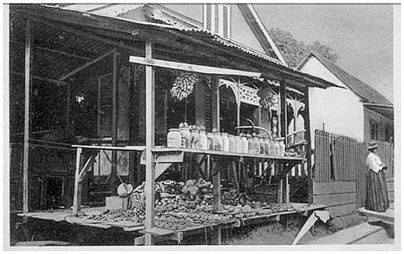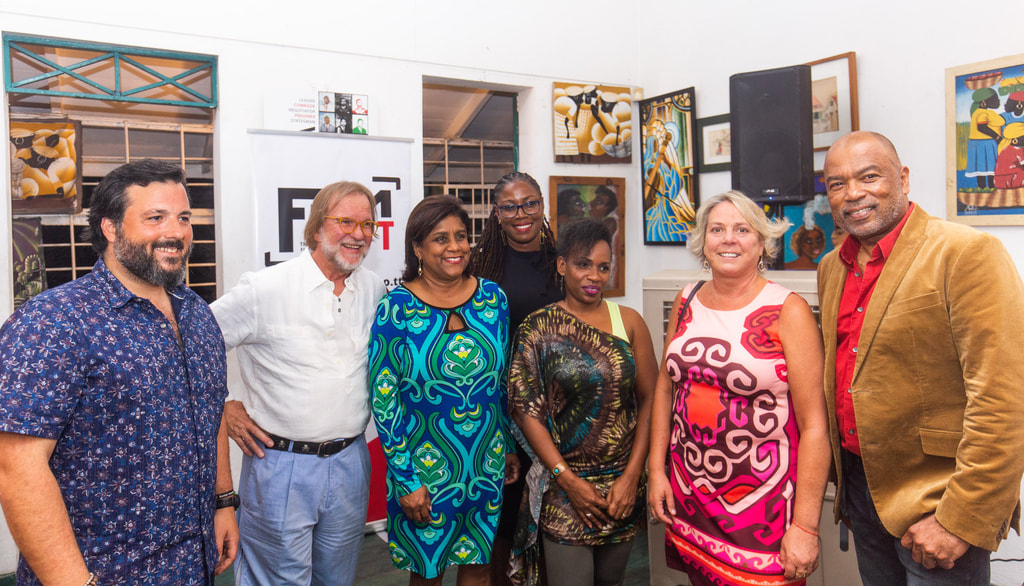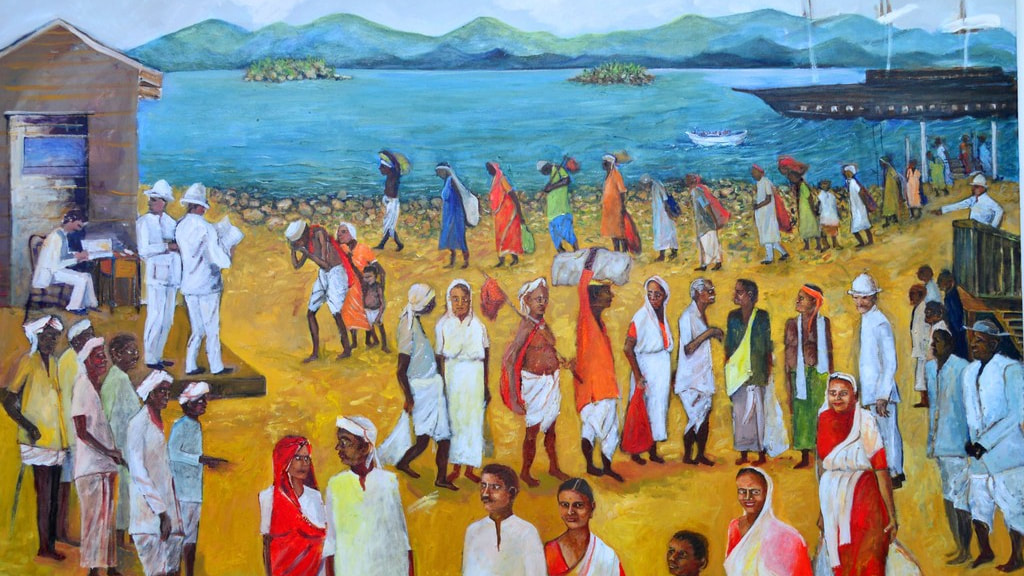|
Five youngsters are representing T&T at a 6-week internship program at the NASA Ames Research Center in California.
Three of them, Keanu Nichols, Gabrielle Motilal and Tevin Achong, are from the UWI, St Augustine Campus while Ruth Jones is from Oxford University and the University of Toronto’s Saanjali Maharaj. The internship program started yesterday (Monday 3rd June, 2019) and will end on August 9th. It emphasizes teamwork and research and also balances science and technology with problems of management, finance, and social and human issues faced by aerospace professionals. Source: 103.1FM, June, 2019
0 Comments
(l-r) Eduardo Rodrigalvarez, Location Manager; Dow Griffith, Location Manager; Senator the Honourable Paula Gopee-Scoon, Minister of Trade and Industry; Nneka Luke, General Manager, FilmTT; Dionne Mc Nicol Stephenson, Chairman, FilmTT; Christine Bonnem, Location Manager and Calvin Bijou, Chairman, CreativeTT(l-r) Eduardo Rodrigalvarez, Location Manager; Dow Griffith, Location Manager; Senator the Honourable Paula Gopee-Scoon, Minister of Trade and Industry; Nneka Luke, General Manager, FilmTT; Dionne Mc Nicol Stephenson, Chairman, FilmTT; Christine Bonnem, Location Manager and Calvin Bijou, Chairman, CreativeTT Earlier this month, the Trinidad and Tobago Film Company Limited (FilmTT) hosted its first Familiarisation Tour (Fam Tour) in many years, to introduce Trinidad and Tobago’s location and production potential to three influential location managers from the US and UK.
This formal introduction to the country and its many attractions serve to better position the country as a competitive destination for international film, television and commercial productions. The Fam Tour, organised by FilmTT in collaboration with the Los Angeles-based Location Managers Guild International (LMGI), saw participation from three senior location managers from the Guild’s membership: Dow Griffith, from Los Angeles, whose nearly 60 screen credits include Mulan (2020), Ghost in the Shell (2017), After Earth (2013), The Bourne Legacy (2012), Contagion (2011), The Last Airbender (2010); Christine Bonnem, location manager for Halt and Catch Fire (30 episodes, 2015-2017), Grace and Frankie (13 episodes, 2015), Fright Night(2011), He’s Just Not That Into You (2009), Bad Santa (2003), American Beauty (1999), Star Trek Generations (1994) among many others; and Eduardo Rodrigalvarez, location manager for Love Island Australia (2018), Ready Player One (2018), Black Mirror (3 episodes, 2016), along with many commercials for high-end brands. The guests, hosted by FilmTT staff, visited more than 50 locations in Trinidad and Tobago over the course of five days, including Paramin, Las Cuevas Bay, Maracas, Bay, Ortinola Great House and Estate; Manzanilla, Temple in the Sea; Hanuman Murti, Tucker Valley including Bamboo Cathedral, and several sites in Tobago, including Pigeon Point and Argyle Falls. According to FilmTT General Manager, Nneka Luke, “Fam Tours are tools that film commissions like ours use to familiarise prospective international directors, producers and location managers with locations and production resources in that country, city or state, and encourage them to bring future productions. "Properly designed and scheduled, the tours are an effective form of marketing that can raise a country and a film commission’s profile, while courting decision makers in the industry. The potential for positive economic impact is an effective selling point to Fam Tour sponsors, film commission investors, and local officials. "The potential return on investment for a Fam Tour is that a large-budget production that decides to shoot here can create jobs in both the creative and service sectors, increase foreign exchange earnings, and expand international visibility for Brand T&T," she continued. "We worked closely with the LMGI to choose a group of guests who could see the potential in T&T’s locations, even as a country with a developing film industry. A few weeks after the Tour, we are already starting to see the potential fruits of these strategic efforts.” Shared LA-based location manager, Dow Griffith, “I really knew initially nothing about the areas here. Having now had the advantage and privilege coming here on this Fam Tour, we realise how revealing and important it is. You have to come here, see it, meet the people and go to the places.” Atlanta-based location manager, Christine Bonnem, described the T&T professionals she met during the tour as “excellent people with great enthusiasm”. FilmTT also relied on its growing list of partners in its Film Friendly Network to demonstrate the increasing focus on making the country more film-friendly for both local and international producers. “As a facilitator of services for the sector, we have been building stronger working relationships with ministries and agencies that have a role to play in making it easier for local and international productions to shoot here," said Luke. "Members of our Network contributed to the Tour’s success, such as the Airports Authority of Trinidad and Tobago, Customs Division, Immigration Division, Chaguaramas Development Authority, Tobago House of Assembly, The US Embassy in Port of Spain, InvesTT and Trinidad Tourism Limited. We must also acknowledge the Inter-American Development Bank (IDB), ExporTT, InvesTT, Airports Authority of Trinidad and Tobago, Trinidad Tourism Limited, Massy Distribution, and Just Juiced for their additional support and commitment to the overall vision of building a successful and lucrative audio-visual industry in Trinidad and Tobago for all its citizens.” At a welcome reception for the visiting guests, Senator the Honourable, Paula Gopee-Scoon, Minister of Trade and Industry, line ministry for FilmTT, stated: “I speak on behalf of the Government when I say we are 100 percent behind FilmTT and its work. This country is very focused on growing the creative industries and we understand the value in it. At the end of the day, this is a business and the Government must support the business of film. Trinidad and Tobago is an ideal destination and it comes back to who we are as a people, our history, what we’ve become and where we are heading.” For more information on the FilmTT, visit www.filmtt.co.tt. Source: The Loop, May 27, 2019  James Cummings, in his seminal work on The Barrack-Yard Dwellers, said, “For the people of the barrack-yards, the sun just had to rise tomorrow.” By this he meant that decades of economic penury in the post-emancipation urban space, leading up to the massive slum clearance exercises of the 1950s, had made the dwellers of the poorer parts of Port-of-Spain masters of coping with poverty. In the areas of Queen Street, Charlotte and Quarry Street where the barrack-yards proliferated, there were occasional wooden cottages owned by more “respectable” coloured people, Venezuelan refugees fleeing political unrest, and white people of reduced means. Many of them would be on the verge of not knowing where tomorrow’s bread would come from. One coping strategy was to open a small “one-door” shop in the front premises of one’s house. This could be in the porch or as a wooden extension. The stateroom at the front of a house is commonly called a parlour. Since these makeshift shops often occupied the aforementioned space, the enterprises themselves became known as parlours. Few, if any, Trinidadians are aware that this was how these vital community establishments came to be called thus. The parlour, in urban and rural areas, became a focal point of social interaction where people, young and old, could meet and exchange the latest gossip. Parlours of yore were places where the fare was manufactured almost entirely by local hands and where simple treats meant so much. They were tenuous businesses where tiny profit margins made their proprietorship more a community service than a get-rich-quick enterprise. For children of yesteryear, there could be few pleasanter places. Large glass jars would be filled with sugar-coated paradise plums, kaisa balls, tangy tamarind balls, molasses-dripping toolum, pink sugar cake and paw-paw balls. A huge block of ice, delivered by a cart in the early morning, would be resting on a piece of sacking, swaddled in straw to keep it from melting too quickly. This ice, of course, would be vigorously shaved, rammed into a metal cup and then covered in sweet, red syrup for a penny, and for another copper, laced with condensed milk to result in that much-relished treat, snowball. Outside of the city and in the countryside, there were parlours too, mostly run by “celestials with pig-tails and thick-soled shoes grinning behind cedar counters, among stores of Bryant’s safety matches, Huntley and Palmer’s biscuits, and Allsopp’s pale ale...” this according to Charles Kingsley, writing in 1870 about a Chinese parlour in the deep countryside. The country parlour often was the oasis of rural travellers, according to one account from 1914: “Restaurants are rare in the West Indies, except in the principal towns, but it is generally possible to obtain something of a simple kind, which on this occasion consisted of that nice aerated drink called kola, together with buns from a stall at the entrance of the same shop.” So then, this is the origin of the parlour, a small-business model which still thrives today. 1908 photo of a parlour in east Port-of-Spain , where the business model developed. In addition to jars of pickles and sweets, this little wayside emporium also sells a variety of fruit and vegetables. Source: Virtual Museum of Trinidad & Tobago A significant Saharan dust event is expected during the first week of June, as a plume of dust is expected to move through the region.
This according to the Trinidad and Tobago Meteorological Service. The Met Office provided a Saharan dust update on Sunday. You can read the update below: “As stated in our previous update, mild concentrations of Saharan dust linger in our atmosphere and is expected to do so into June. Keep in mind that mild concentrations can also have an impact on those that are more sensitive. Latest data also suggests that is significant event is possible during the first week of June, as a plume of dust is expected to move through the region within a wind surge.” Persons with respiratory ailments are advised to take the necessary precautions. Arrival, the painting by Shastri Maharaj which led to a full exhibition showcasing Indo-Trinidadian history and culture at the Divali Nagar Art Gallery. The Divali Nagar now has an art gallery. The gallery, located in the Divali Nagar compound in Chaguanas, is the fulfilment of a vision theNational Council for Indian Culture (NCIC) has harboured for many years.
Deokinanan Sharma, President of the NCIC, said they discussed their vision with different artists who refused to entertain the notion of showing their work outside of Port-of-Spain. “It was not the place for exhibiting artwork. The idea was rejected outright, not because they didn’t want to come here but the feeling was that the audience and people would not come here. Port-of-Spain is established and is the capital city,” he told Loop, noting that, as far as he knows, there are no other art galleries in Central Trinidad. Loop discovered one other art gallery located in Freeport that mainly exhibits work produced from student classes. That the Divali Nagar gallery is now a reality is thanks to artist Shastri Maharaj who decided last year to approach the NCIC about staging an exhibition in time for Indian Arrival Day. His exhibition Aagaman: The Coming, chronicles the arrival of East Indians to Trinidad and showcases the culture and rituals that are now part of the fabric of T&T. Maharaj said when he approached the NCIC with his idea they were pleasantly surprised. “Nobody before really showed at the Nagar at this scale and this level with this kind of profile. It was the first for the Divali Nagar and the first for Central Trinidad,” he said. “In sensitising people about these activities about what Indian people do, I felt that South of the Caroni is most appropriate in a grassroots environment where it is the kind of motherland for Indian people, sugar cane and that indigenous Indian thing, the chutney, the Tassa,” he said. He said the NCIC welcomed his interest as they were concerned about the preoccupation of Indian culture in Trinidad as just song and dance whereas in India visual arts is a huge thing. “Film India indoctrinated the Indian audience to song and dance and they cultivated that sensibility and idea…art was like a non-existent thing,” said Maharaj. The exhibition itself is a first as no artist has before presented the Indian experience in T&T on such a large scale. Maharaj said it started with one painting called Arrival, which documents East Indians landing on Nelson Island which served as a clearinghouse of sorts for the Indentured Labourers. “Amidst the research, it occurred to me that I seem to be so caught up in it that it would be a good idea to expand it and document visually other things related to Indians,” he said. Maharaj, who, growing up in the urban environment of San Fernando, tried to suppress his heritage and culture, said the research activated his muse. “It meant that I could investigate a lot of things Indian and Hindu that I was not aware of and if I name Maharaj, growing up in a Hindu family and I didn’t know about these things, you could imagine non-Hindu people?” he asked as he described his first experience at the Ganga Dhara festival in Blanchisseuse, which marks the coming to earth of the female deity Ganga. His paintings of the event capture the vivid yellows and oranges of the clothing worn by the devotees as they walked through the water and the sunlight trickling through the foliage. “I decided if I could do Indian Arrival and I could do this Ganga Dhara thing, then maybe I could try Tassa, Divali, maybe I could try other things Indian and let me expose the Indian culture in ways it has not been exposed to the wider Trinidad audience,” Maharaj said. The collection comprises 40 pieces which Maharaj considers seminal and epic. Maharaj said his work also contains influences from Indo-Trinidadian artists who have gone before such as Dr James Isaiah Boodoo, Mahmoud Pharouk Aladdin, Jones Gilbert and Sonnylal Rambissoon. Maharaj said he wants to encourage all artists, especially the youth, to show their work at the Art Gallery as well as the public to visit and purchase the pieces. “The objective I think with NCIC is to sensitise the people out there, the artists, the budding artists and the young people that this is a space you can utilise and you can come and see work and be influenced or you can be mentored into discovering more about yourself through the work. It is that kind of objective I had in mind with NCIC to get the involvement of the young, to get this exposure and awareness,” he said. “The prime objective is to have the ordinary man, the people who normally would not have the opportunity or take the time to go to Port-of-Spain to go to an art gallery to look at work, While they are shopping, while they are driving around, they can bring their family free of charge and just simply embrace and look at the art. The aim is to take the ordinary and make it extraordinary.” The exhibition will run until June 2. It forms part of Heritage Month activities which will culminate on Indian Arrival Day on May 30. For more information on the pieces please visit the online catalogue. To connect with the NCIC visit the NCIC Heritage Centre Facebook Page . Source: The Loop, May 2019 |
T&T news blogThe intent of this blog is to bring some news from home and other fun items. If you enjoy what you read, please leave us a comment.. Archives
May 2025
Categories
All
|




 RSS Feed
RSS Feed